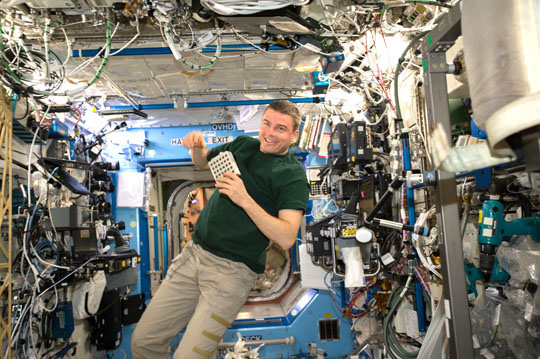Research at The University of Toledo could lead to new treatments for a type of bacteria that is in the stomach of half the world’s population, causes ulcers, and is linked to the development of stomach cancer, one of the most common causes of cancer death worldwide.
And astronauts on the International Space Station played a key role in making the experiment possible.

NASA astronomer Reid Wiseman on the International Space Station held Dr. Donald Ronning’s experiment before he activated it. For six months, the protein crystals circled Earth as they grew.
“There are no current drugs on the market that target this special enzyme called MTAN found in the bacterium,” Ronning said. “The enzyme synthesizes vitamin K2 and is essential for the bacterium to survive.”
Most of the people who have an H pylori bacterial infection are treated with general antibiotics that are 50 years old, and in some regions of the world 30 percent of the strains are resistant to those drugs.
“It’s likely that inhibitors targeting this enzyme can lead to the development of medication specifically targeted to kill bad bacteria without harming useful bacteria or human cells in the gastrointestinal tract,” Ronning said.
The research, which was supported by a NASA grant and done in collaboration with the Oak Ridge National Laboratory in Tennessee and the Technical University of Munich in Germany, was recently published in the Proceedings of the National Academy of Sciences. UT graduate student Mike Banco also participated in the study.
The first six months of Ronning’s stomach bacteria experiment took place on the International Space Station, which orbits Earth approximately 16 times a day.“We sent samples of the protein we were trying to inhibit on a SpaceX rocket up to the International Space Station’s microgravity environment in 2014,” Ronning said. “Astronauts activated the experiment and helped us grow the large, high-quality crystals of these proteins we needed in order to use a rare methodology called neutron diffraction.”
When the proteins were returned to Earth on a SpaceX rocket, the largest crystals were the size of a grain of rice or the width of a paperclip.
Ronning based his structural determination of the enlarged, crystallized proteins using neutron diffraction, which affords visualization of hydrogen atoms in the protein.
“The usual methods for determining three-dimensional structures of molecules, such as x-ray diffraction, don’t allow us to see hydrogen atoms and their movements that are vital to the function of enzymes synthesizing vitamin K2,” Ronning said. “Instead, we used neutron diffraction for our crystal structure analysis, which allows us to see the hydrogen atoms and shows us how they do their job in the protein. In the history of mankind, there have been 106 molecular structures solved using this technique. It’s an expanding field.”
Based on the findings, it is now possible to develop molecules that are better at blocking the enzyme’s reaction process.
“By seeing what the protein looks like in a 3D model and understanding how it functions, we have a better idea of how to create a drug to prevent that function and would kill the bacteria causing the infection in the gastrointestinal tract,” Ronning said.